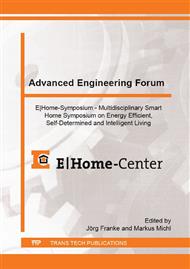[1]
A. Dr. Gentner and A. Prof. Dr. Mohnen, Ready for Takeoff? Smart Home aus Konsumentensicht, Deloitte & Technische Universität München, 2015. [Online] Available: http: /www2. deloitte. com/de/de/pages/technology-media-and-telecommunications/articles/smart-home-consumer-survey. html-takeoff/deloitte-smart-home-consumer-survey-20150701. pdf. Accessed on: Jun. 29 (2016).
Google Scholar
[2]
Qivicon, Leben im Smart Home: Eine Plattform, viele Marken, noch mehr Möglichkeiten: Ihre persönliche Smart Home Beratung. [Online] Available: http: /www. smarthomeberater. info/. Accessed on: Jul. 01 (2016).
Google Scholar
[3]
RWE, RWE Smart Home. [Online] Available: www. rwe-smarthome. de. Accessed on: Jul. 01 (2016).
Google Scholar
[4]
C. Reinisch, M. J. Kofler, and W. Kastner, ThinkHome: A Smart Home as Digital Ecosystem, EURASIP Journal on Embedded Systems, no. 1, p.1–18, (2011).
DOI: 10.1155/2011/104617
Google Scholar
[5]
N. Shah and K. -M. Chao, Ontology for Home Energy Management Domain, in vol. 167, Communications in Computer and Information Science: Digital information and communication technology and its applications: Springer, 2011, p.337–347.
DOI: 10.1007/978-3-642-22027-2_28
Google Scholar
[6]
E. Kim and J. Choi, An Ontology-Based Context Model in a Smart Home, in Computational Science and Its Applications-ICCSA 2006: Springer, 2006, p.11–20.
DOI: 10.1007/11751632_2
Google Scholar
[7]
T. van Nguyen, W. Lim, H. A. Nguyen, D. Choi, and C. Lee, Context Ontology Implementation for Smart Home, " 2nd International Conference on Ubiquitous Information Technologies & Applications (ICUT, 07), (2010).
Google Scholar
[8]
D. Bonino and F. Corno, DogOnt - Ontology Modeling for Intelligent Domotic Environments, in The Semantic Web - ISWC 2008: 7th International Semantic Web Conference: Springer, 2008, p.790–803.
DOI: 10.1007/978-3-540-88564-1_51
Google Scholar
[9]
N. F. Noy and D. L. McGuinness, Ontology development 101: A guide to creating your first ontology, Stanford knowledge systems laboratory technical report KSL-01-05, (2001).
Google Scholar
[10]
R. Glasberg and N. Feldner, Leitfaden zur Heimvernetzung, Bedeutung und Nutzen der Heimvernetzung, vol. 8, (2009).
Google Scholar
[11]
H. Strese, U. Seidel, and T. Knape, Smart Home in Deutschland: Untersuchung im Rahmen der wissenschaftlichen Begleitung zum Programm Next Generation Media (NGM) des Bundesministeriums für Wirtschaft und Technologie, Institut für Innovation und Technik (iit) in der VDI/VDE-IT, (2010).
DOI: 10.5771/9783845222035-111
Google Scholar
[12]
A. Gentner and G. Wagner, Licht ins Dunkel: Erfolgsfaktoren für das Smart Home. [Online] Available: https: /www2. deloitte. com/content/dam/Deloitte/de/Documents/technology-media-telecommunications/TMT-Studie_Smart%20Home. pdf. Accessed on: Sep. 05 (2016).
Google Scholar
[13]
F. Manola, E. Miller, and B. McBride, RDF primer, W3C recommendation, vol. 10, no. 1-107, p.6, (2004).
Google Scholar
[14]
M. R. Genesereth and R. E. Fikes, Knowledge interchange format-version 3. 0: reference manual, Computer Science Department, Stanford University, (1992).
Google Scholar
[15]
I. Horrocks, DAML+OIL: A Description Logic for the Semantic Web, IEEE Data Eng. Bull, vol. 25, no. 1, p.4–9, (2002).
Google Scholar
[16]
I. Horrocks et al, SWRL: A semantic web rule language combining OWL and RuleML, W3C Member submission, vol. 21, p.79, (2004).
Google Scholar
[17]
M. O'connor and A. Das, SQWRL: a Query Language for OWL, Proceedings of the 6th International Conference on OWL: Experiences and Directions, no. 529, (2009).
Google Scholar


